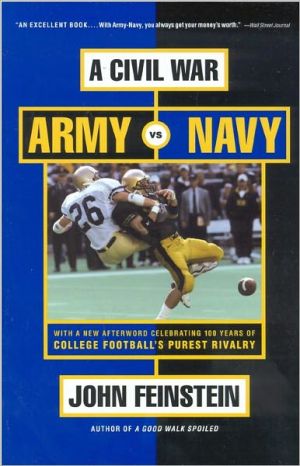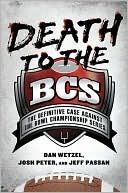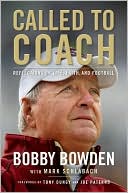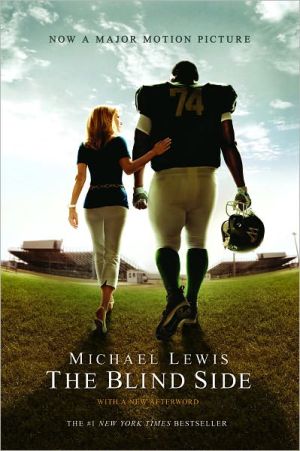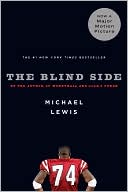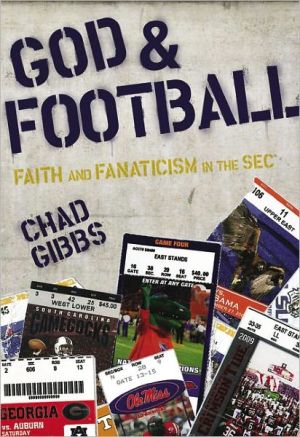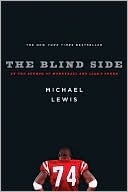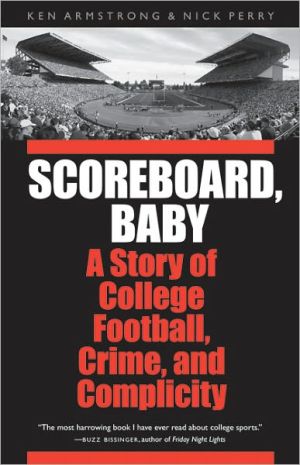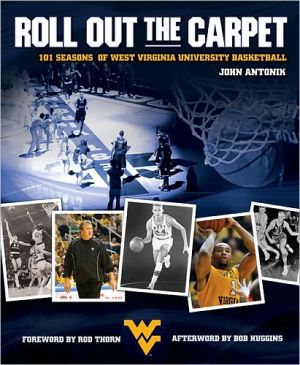Civil War: Army vs. Navy, A Year Inside College Football's Purest Rivalry
A Civil War portrays American college football in what the author believes is its purest form: two teams who play for love of the game & the honour of their schools, rather than for money or fame. He follows the Army and Navy teams for a single season.
Search in google:
The bestselling book of 1996 -- the book in which a fierce gridiron rivalry comes dramatically to life. Publishers Weekly Although neither Army nor Navy is a college football power anymore, their annual rivalry still attracts national attention, and the game between the two service academies is the most important contest for both schools every season. In chronicling the 1995 game (the 96th meeting between the two teams), Feinstein (A Good Walk Spoiled) provides readers with a comprehensive backdrop to the game by recounting the events leading up to Army vs. Navy. Given almost unlimited access to the players and coaches, Feinstein does a superb job of capturing the emotional and physical impact the long season has on the team members of both sides, while also giving a taste of what life is like at Annapolis and West Point. Feinstein focuses his story by concentrating on a number of players at the two schools, providing brief backgrounds and their reasons for attending the academies. Among the players featured are Army's Jim Cantelupe and the offensive linemen nicknamed "The Fat Men," as well as Navy's Andrew Thompson and Chris McCoy. Providing an extra touch of drama is the fact that 1995 was the last year of Army coach Bob Sutton's contract, and his future at the school would be determined by the Cadets' performance in the Navy game. It is to Feinstein's credit that, although the outcome is already in the history books, he builds a sense of excitement and anticipation throughout the book about what would happen in the contest. (Army won.) (Nov.)
Chapter 1\ BROTHERHOODALMOST thirty minutes after the last play of his college football career, Jim Cantelupe, still dressed in the black uniform with the gold number 22 on the back and front, walked down a dank, winding hallway in the bowels of Philadelphia's Veterans Stadium.\ The scene on the field immediately after the final gun had been chaotic. In between hugs from teammates and the screams and yells of the West Point cadets who had poured onto the artificial playing surface, Cantelupe had searched unsuccessfully for Andrew Thompson.\ He knew Thompson was devastated. Four years of playing football for Navy had just ended with a fourth-straight hard-to-believe loss to Army. Four games, four Army victories. Total margin: six points. This time it had been Army 14, Navy 13, the Cadets driving 99 1/2 yards to score the winning touchdown with 63 seconds to play.\ It was an unforgettable drive. One that Army's players would savor forever; one that Navy's players would be haunted by for just as long.\ Cantelupe, Army's defensive captain, and Thompson, his counterpart at Navy, had met twelve days earlier at the annual Army-Navy press conference. Each had understood immediately that the other was a soul mate. Neither was blessed with superior speed or size or ability. Neither had been recruited by any big-time football schools. Both simply loved the game, the competition, the camaraderie. Both had put up with the frustrations and vagaries of military academy life for four years for one reason: the chance to play big-time football.\ "If you can't play for Notre Dame," Cantelupe liked to say, "the next best thing is to play against Notre Dame."\ Cantelupe knew how badly he wanted to win his last football game. He knew Thompson had wanted to win just as much. And so, while his teammates continued to hug and pummel one another in celebration, he quietly slipped out of the locker room and walked down the hall in the direction of the Navy locker room.\ "Is it OK if I go in there?" he asked a security guard.\ The man looked at him quizzically, as if to say, "Why would you want to do that?" But seeing the Army uniform, he nodded his head and stepped aside. Cantelupe walked through the doorway, took three steps into the locker room, and came to a dead halt.\ His stomach twisted into a knot and for a split second he thought he might get sick. The silence in the room was deathly. Players in various stages of undress stood in groups of two and three, hugging one another or talking in hushed tones. Others sat in front of their lockers staring into space.\ Father William Devine, one of Navy's team chaplains, his eyes puffy and red too, stood a few feet from the doorway when Cantelupe walked in. "Father," Cantelupe said softly, apologetically, "I was hoping to see Andy Thompson."\ Devine nodded and pointed his hand at a locker several feet away. Thompson was sitting there, still in uniform, his head down, staring at the floor. Cantelupe could see that he was still shaking from a crying jag. Gingerly, he stepped over a couple of towels and gently put a hand on Thompson's shoulder.\ Thompson looked up, expecting to see another teammate or a coach or a member of the Navy brass. When he saw Cantelupe, he jumped to his feet, threw his arms around him, and began to sob again. Cantelupe put his arms around Thompson and said softly, "I know."\ They walked into the hallway so that Thompson's teammates would not have to look at a player in black and gold.\ "Dammit, I wanted to kick your ass today," Thompson said, his voice hoarse from shouting and crying. "Just once I wanted to know what it felt like to beat you guys. Now, I'll never know."\ "You're a hell of a football player," Cantelupe said, meaning it, remembering the panic he had felt when Thompson had sacked his quarterback, Ronnie McAda, for a 12-yard loss on Army's final, desperate drive.\ Thompson almost smiled. "That's the worst part, Jim. We're not football players anymore. It's all over now."\ Cantelupe had thought about that a lot during the week prior to the game. He and his fellow first classmen had talked about it at length the night before. A few minutes earlier, one of his teammates, Eddie Stover, had gone crazy in the locker room at the thought of not being a football player anymore.\ "How will I live without football?" Stover had screamed. "It's all I've ever known!"\ Cantelupe wasn't very different from Stover. Or Thompson. Now, it was real. He wasn't a football player anymore. "They can't take away the memories," he said to Thompson. "They can't take away the way it felt out there today."\ Thompson's eyes were still glistening. "We're brothers now," he said. "For the rest of our lives."\ "Damn right," Cantelupe said.\ This time, he hugged Thompson, the gold number 22 on his chest colliding with the blue number 32 on Thompson's. The closeness they felt at that moment is usually only felt by men who have gone to war together.\ Of course, they had been to war. Just on opposite sides.\ *****\ THE notion of football as war has been used as a metaphor for as long as the game has been played. Coaches see themselves as generals, their assistants as the officers, the players as the soldiers. The violent nature of the sport lends itself easily to the notion that every game is about killing or being killed.\ It is logical, then, that the military academies, which train young men—and, for the last twenty years, women—to fight wars, would play football with great passion. And once upon a time, when there was a military draft that meant many athletes had to serve in the armed forces, when being a military officer paid as much as or more than a job in the National Football League paid, and when the United States was undefeated in war, truly great and gifted football players flocked to West Point to play for Army and to Annapolis to play for Navy.\ The football history of the two academies dates back to 1879, when Navy played the Baltimore Athletic Club to a scoreless tie, and to 1890, when cadet Dennis Michie challenged Navy to a game at West Point. The Midshipmen won easily, 24-0, but 105 years later the Army media guide makes the point that "the Midshipmen were a far more experienced team." No one concedes anything in this rivalry without a fight.\ The football history of both academies is full of glory and glamorous names, whether they are Glenn Davis, Doc Blanchard, and Pete Dawkins at Army in the forties and fifties or Joe Bellino and Roger Staubach at Navy in the sixties. All won Heisman Trophies. All played for powerful, nationally ranked teams. All went on to serve their country.\ Once upon a time, Army-Navy was the game of any college football season. Often when they played, the national championship was at stake, especially during the forties, when Army won the championship three straight times ('44-46) and went undefeated five times in six years from '44 through '49.\ The entire nation would come to a standstill for one Saturday afternoon while the Cadets and Midshipmen, America's best and brightest, dueled on the gridiron. Every major newspaper in the country covered the game, often with two or three reporters and several photographers. The outcome was the lead story in every sports section the next day. Often it was front page news.\ The last vestiges of that glory were played out in the 1960s. Staubach led Navy to a 9-1 record, a berth in the Cotton Bowl and a number two national ranking in 1963, his Heisman Trophy season. Four years later, Army was 8-1 going into the Navy game and was invited to the Sugar Bowl. The Pentagon, concerned about security in the midst of the growing controversy surrounding the Vietnam War, would not allow the Cadets to accept the invitation.\ The morning after the announcement was made, the Corps of Cadets marched into the mess hall for breakfast and found clumps of sugar piled up in the middle of all the tables. From the poop deck in the middle of the huge room hung a sign: "No Sugar Bowl for the football team; no sugar bowls for the corps."\ The cadets cheered the sugar bowl thieves wildly. That was the last time either Army or Navy has been invited to a major bowl game.\ Vietnam was a major turning point in the history of military academy football. The popularity of the military dropped considerably during those years, and with graduates from West Point and Annapolis being shipped to Vietnam almost the moment they were commissioned as officers, the notion of a four-year postgraduate military commitment wasn't nearly as romantic as it had once been.\ Beginning in 1969, Army had two winning seasons (both times at 6-4) in fifteen years, including an 0-10 season in 1973. Coaches came and went. The school had five of them during that period. Navy suffered through seven straight losing seasons from 1968 through 1974 before George Welsh, a 1956 graduate of the academy, returned to resurrect the program, producing five winning seasons in seven years and three bowl appearances.\ By that time, Army-Navy had lost a good deal of luster, at least in the eyes of big-time football fans across the country. The game was still on national TV and always drew a respectable rating, but it wasn't the media event it had once been. Both schools began playing easier schedules, adding games against smaller schools from Division I-AA and dropping some of the national powers that had once been traditional opponents. Many in the national media suggested they should give up big-time football altogether and play an Ivy League type of schedule. Yale and Harvard seemed like far more reasonable opponents than Notre Dame and Tennessee.\ The losing and the watered-down schedules caused considerable grumbling among the old grads around the country who simply couldn't understand why beating Notre Dame and Oklahoma and Penn State was any more difficult in the eighties and nineties than it had been in the forties and fifties. When the two schools actually lost on occasion to schools like Delaware and Boston University and—God forbid—The Citadel, the screaming from alumni could be heard from one corner of the nation to the other.\ Even worse, the steady slide at Army and Navy coincided with the rise of the upstart Air Force Academy. While the two tradition-laden schools were struggling to get to .500 even against weaker schedules, Air Force had joined the Western Athletic Conference and had built a solid program that produced winning seasons consistently and bowl trips often. Beginning in 1982, Air Force dominated both Army and Navy, winning the Commander in Chief' s Trophy nine times in twelve years. The CIC, as it is called at the three academies, goes to the school with the best record in inter-academy play each season.\ Air Force became so dominant in CIC play that in 1995 several of their players said publicly that winning a Western Athletic Conference title was more important to them than the CIC. The players at Army and Navy were galled and hurt by the comments. But Air Force still beat them both—again.\ In spite of their preeminence on the field against their military brethren, Air Force chafed because it could not compete with Army-Navy in terms of tradition or national attention. While CBS and ABC were both bidding for the Army-Navy contract in 1994, no one was lining up for the chance to televise Air Force-Army or Air Force-Navy. And while the players at Air Force made a point of looking down their noses at Army and Navy on the football field, the other two schools did the exact same thing off the field. The cadets and midshipmen mockingly called Air Force "The Country Club Academy" because of the relatively plush dorms and more relaxed campus atmosphere.\ Air Force won the football games; Army and Navy won just about everything else. Air Force was the little brother screaming for attention. No matter how good it got, no one seemed to take much notice.\ Which is not to say that the ongoing struggles at Army and Navy did not cause a good deal of consternation at the schools. When Welsh, feeling he had gone as far as he could at his alma mater, left for Virginia in 1982, the Navy program went into a steady downward spiral. Gary Tranquill, Welsh's successor, went 6-5 in his first season. After that it was one losing season after another, including back-to-back 110s under George Chaump in 1991 and 1992. By the time Chaump became the third post-Welsh Navy coach to be fired in December of 1994, Navy had been through twelve straight losing seasons.\ Army had experienced a Welsh-like renaissance in the 1980s when coach Jim Young, after a 2-9 rookie season in 1983, decided that the best offense for a school that couldn't recruit six-foot-five-inch quarterbacks with shotgun arms or 300-pound linemen was the wishbone. That way the quarterback had to throw only rarely, and quickness and toughness were as important on the offensive line as size and strength.\ Army went 8-3-1 in 1984 and appeared in its first bowl game ever, the now-defunct Cherry Bowl. It was 9-3 a year later and played in the Peach Bowl and went to a third bowl in 1988, the Sun Bowl. In all, Young and his wishbone produced six winning seasons in seven from 1984 through 1990 before he retired, turning the job over to his defensive coordinator, Bob Sutton.\ Sutton had never been a head coach before, and following in Young's large footsteps wasn't easy. During his first four seasons, he had a winning record once (6-5 in 1993), and by the end of a 4-7 1994 season Sutton was under considerable pressure, much of it from those old grads who still couldn't quite understand why Army hadn't recruited the next Blanchard or Davis yet.\ Sutton, who became Army's thirty-first coach six weeks before he turned forty, might not have been retained for the final year of his five-year contract if not for his ability to steal final-second victories from Navy. After losing his first Army-Navy game as a head coach in 1991, Sutton won in 1992 on a 49-yard field goal on the game's final play; won in 1993 when Navy missed an 18-yard field goal as time expired; and won in 1994 on a 52-yard field goal. Three games, three victories. Total margin: five points.\ But when Sutton assembled his 1995 team for spring practice, he knew that a victory over Navy was not going to be enough to earn him a new contract. A winning season would probably be needed, and a victory over Air Force—which had last happened in 1988—might also be required. At Navy, the goal for 1995 was more direct: "Beat Army?" Absolutely. But for starters, beating anyone would be just fine.\ © 1999 by John Feinstein "
\ Publishers Weekly - Publisher's Weekly\ Although neither Army nor Navy is a college football power anymore, their annual rivalry still attracts national attention, and the game between the two service academies is the most important contest for both schools every season. In chronicling the 1995 game (the 96th meeting between the two teams), Feinstein (A Good Walk Spoiled) provides readers with a comprehensive backdrop to the game by recounting the events leading up to Army vs. Navy. Given almost unlimited access to the players and coaches, Feinstein does a superb job of capturing the emotional and physical impact the long season has on the team members of both sides, while also giving a taste of what life is like at Annapolis and West Point. Feinstein focuses his story by concentrating on a number of players at the two schools, providing brief backgrounds and their reasons for attending the academies. Among the players featured are Army's Jim Cantelupe and the offensive linemen nicknamed "The Fat Men," as well as Navy's Andrew Thompson and Chris McCoy. Providing an extra touch of drama is the fact that 1995 was the last year of Army coach Bob Sutton's contract, and his future at the school would be determined by the Cadets' performance in the Navy game. It is to Feinstein's credit that, although the outcome is already in the history books, he builds a sense of excitement and anticipation throughout the book about what would happen in the contest. (Army won.) (Nov.)\ \ \ \ \ Library JournalFeinstein has a formula: He gets on the inside of a sport and reports what happens over a period of time. He has done it for golf (A Good Walk Spoiled, LJ 2/15/95), tennis, basketball, baseball, and now college football. In this latest endeavor, he examines the rivalry surrounding the annual Army-Navy football game. Feinstein follows both institutions through the 1995 season and, as with all his books, he writes about much more than just the sport. In examining the military academies, Feinstein puts the reader there, describing daily routines for cadets and midshipmen. Part of what makes the book stand out is that the players involved are true scholar-athletes; they are not using their schools as a stepping-stone to the pros. Highly recommended for athletes and their parents, and for all public and high school libraries. [Previewed in Prepub Alert, LJ 0/00/96.]William O. Scheeren, Hempfield Area H.S. Lib., Greensburg, Pa.\ \ \ Kirkus ReviewsFeinstein, author of the bestselling A Good Walk Spoiled (1995), again delivers the goods, this time chronicling the 1995 season of the West Point and Annapolis football teams, culminating in their annual game.\ Once a contest that factored heavily in deciding the national college football championship, the annual Army-Navy showdown has gradually been relegated to something approaching sideshow status. Still, to Cadets and Midshipmen alike, no other event during the year means as much as the chance to wrest honor from their rival academy. Feinstein sets the scene by recounting how rigid military discipline and withering academic standards combine to make football at West Point and Annapolis unlike football at any other division I schools. As one former coach says, "At every other school in America, the hardest part of any football player's day is football practice. At the military academies, the easiest part of a football player's day is football practice." Going into the 1995 season, Army and Navy seemed to be headed in opposite directions. Rocked by a series of academic scandals and other tragedies, Navy's morale was low. The West Point team, by contrast, seemed to be brimming with optimism and spirit. During the course of the season, however, both teams played with enough grit and skill to restore some luster to their somewhat tarnished football reputations. Both pulled off a few upsets; both won most of the games they were supposed to win; both lost close games to their mutual pigskin rival, Notre Dame. For Navy, however, the season's real goal was to break Army's recent stranglehold on the series. Army also had a lot at stake: namely, the chance for the team's seniors to be the first Cadet class since 1948 to go 4-0 against Navy.\ The game, a narrow one-point victory for Army, provided a stunning climax to the season. It also supplies a stirring ending for this exceptional book.\ \ \
